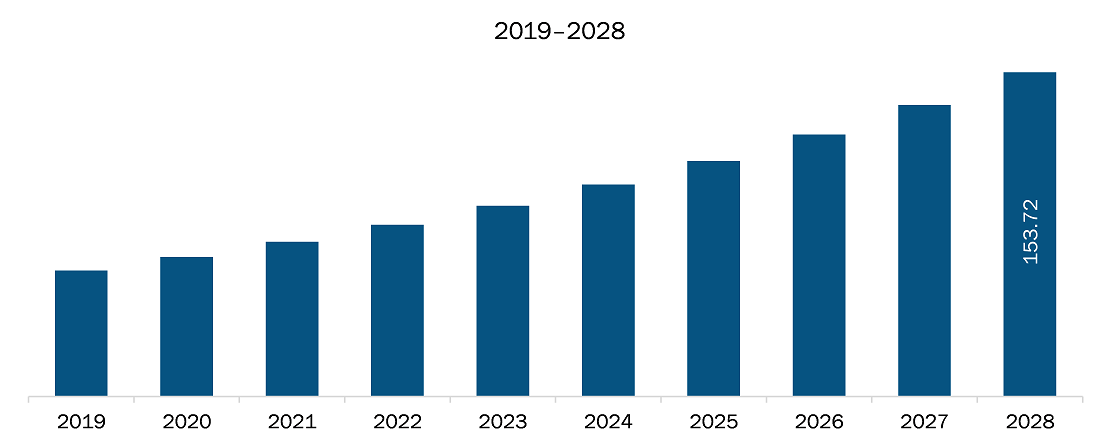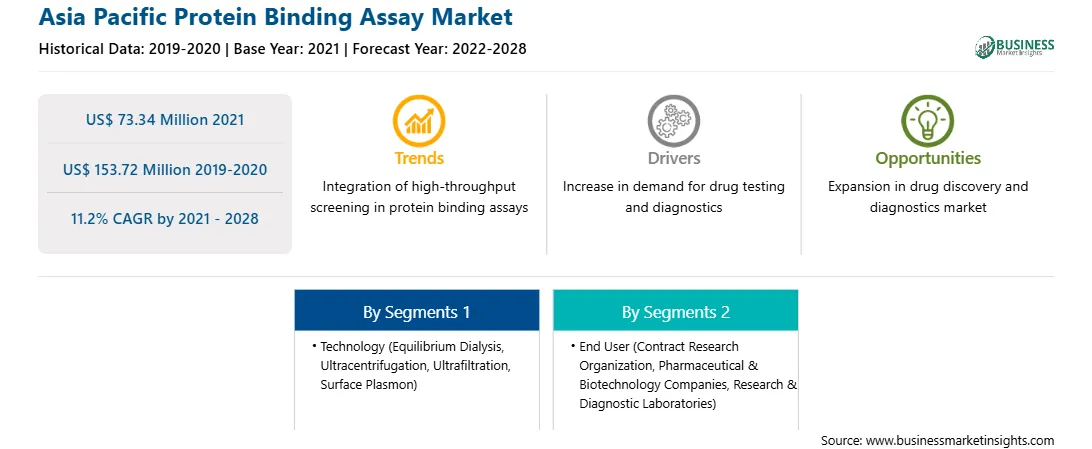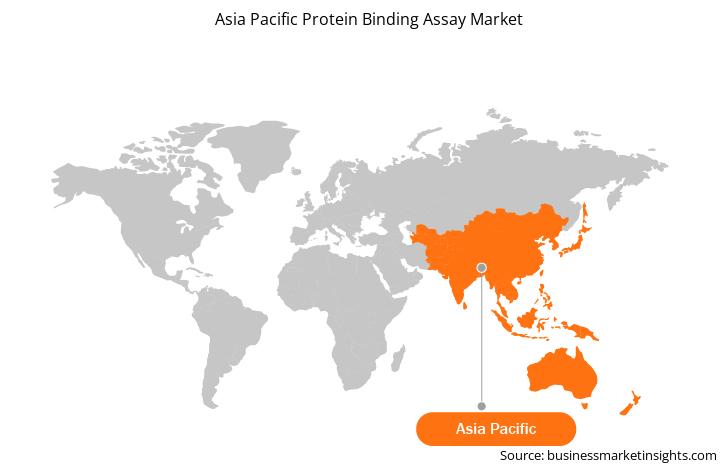Asia Pacific includes countries such as China, Japan, India, Australia, South Korea, and the rest of Asia Pacific. This region accounted for being fastest-growing region of the global protein binding assay market in 2019 owing to substantial number of CROs operating in the space; growing pressure to reduce drug discovery and development costs; growing healthcare expenditure; increase in developments in the pharmaceutical and biotechnological industries in India and China; expanding research base across India, China, and Japan; and increasing pharmaceutical R&D expenditure. In the Asia Pacific region, China is the largest market for protein binding assay. The growth of the market is primarily attributed to several new discoveries driven by research & development and rising number of clinical trials in the country. The growth of the market is attributed to the increasing R&D activities, rising investments in the healthcare sector in developing countries, and increasing collaborations between regulatory outsourcing and drug developers. As per the Government of China in January 2018, China's 13th five-year plan stipulates that biotechnology sector is expected to exceed around 4% of gross domestic product by 2020. Also, China has more than 100 life science parks and approx. USD 100 billion has already been invested by Chinese government to promote biotechnology. In December 2018, PAREXEL, a leading innovator in global biopharmaceutical services, announced a new collaboration with Eli Lilly and Company to launch a clinical research learning and development program in China. The program will provide high-value training opportunities for Chinese clinical trial sites and investigators, enhance local clinical trials, and drive innovation in China's biopharmaceutical industry. To encourage innovation in drug development, the Chinese government has recently launched a series of new policies for clinical research, resulting in a sharp increase in the number of clinical trials in China. According to China's clinical trial registration platform, 1,258 drug clinical trials were first registered and published in China in 2017, an increase of 62.66% compared to 2016. A recent report indicates that the total number of class 1.1 chemical drugs and class 1 biologic drugs approved for clinical trials from January to October 2017 was three times that of 2014. However, the number of GCP-qualified clinical trial sites did not increase significantly between 2014 and 2016. In 2017, China implemented sweeping reforms to its regulatory system, closely aligning the rules governing the world's second-largest drug market with the US and Europe. The result was a sharp rise in applications by Chinese biotech companies to register innovative therapies in the US. IND filings jumped from 11 in 2016 to 20 in 2017 and almost doubled again with an additional 38 applications in 2018 and the first quarter of this year. Chinese policy changes also prompted Western firms to tap China's much larger patient pool to simultaneously access high-quality clinical data to support US registration and, around the same time, to gain rapid registration in China. The increasing adoption of protein binding assays in drug discovery & development offering lucrative opportunities for the protein binding assay market
According to Worldometer, from its epicenter in China, SARS-CoV-2 has spread to infect ~58,231,688 people in Asia, as of July 29, 2021. Following the terrible loss of lives, economies in Asia Pacific have collapsed during the pandemic. The pandemic has emphasized health data exchange and interoperability under a microscope. The supply chain disruptions, along with the tremendous demand for efficient treatments against COVID-19, have put the healthcare research industry in a crucial situation in region. Socioeconomics in countries such as India, China, Japan, and South Korea were severely affected, resulting in rise in inflation, decrease in GDP, and surge in unemployment.

Strategic insights for the Asia Pacific Protein Binding Assay provides data-driven analysis of the industry landscape, including current trends, key players, and regional nuances. These insights offer actionable recommendations, enabling readers to differentiate themselves from competitors by identifying untapped segments or developing unique value propositions. Leveraging data analytics, these insights help industry players anticipate the market shifts, whether investors, manufacturers, or other stakeholders. A future-oriented perspective is essential, helping stakeholders anticipate market shifts and position themselves for long-term success in this dynamic region. Ultimately, effective strategic insights empower readers to make informed decisions that drive profitability and achieve their business objectives within the market.

| Report Attribute | Details |
|---|---|
| Market size in 2021 | US$ 73.34 Million |
| Market Size by 2028 | US$ 153.72 Million |
| CAGR (2021 - 2028) | 11.2% |
| Historical Data | 2019-2020 |
| Forecast period | 2022-2028 |
| Segments Covered |
By Technology
|
| Regions and Countries Covered | Asia-Pacific
|
| Market leaders and key company profiles |
|
The geographic scope of the Asia Pacific Protein Binding Assay refers to the specific areas in which a business operates and competes. Understanding local distinctions, such as diverse consumer preferences (e.g., demand for specific plug types or battery backup durations), varying economic conditions, and regulatory environments, is crucial for tailoring strategies to specific markets. Businesses can expand their reach by identifying underserved areas or adapting their offerings to meet local demands. A clear market focus allows for more effective resource allocation, targeted marketing campaigns, and better positioning against local competitors, ultimately driving growth in those targeted areas.

The protein binding assay market in APAC is expected to grow from US$ 73.34 million in 2021 to US$ 153.72 million by 2028; it is estimated to grow at a CAGR of 11.2% from 2021 to 2028. Rising pressure to reduce drug discovery and development costs; the cost of developing new drugs remains high at an inflation-busting rate, and returns and profits on investments are declining, placing pressure on the entire innovative medicine system. Many research-based pharmaceutical and biopharmaceutical companies are reevaluating old R&D policies and focusing their efforts on improving efficiency, increasing output, and satisfying unmet patient requirements due to current economic and political pressures to reduce the healthcare cost. The changing focus on drug discovery and development, and the rising use of new technologies for identifying and screening drug candidates create new opportunities to target various chronic, degenerative, and life-threatening diseases that were previously untargeted. The process of discovering and developing a drug is costly, as it requires investments in funding, human resources, and technologies. Before launching a new drug in the market, strict adherence to regulations on testing and manufacturing standards is required. Furthermore, if a drug candidate fails during the development stage, the entire investment gets wasted. Protein binding studies aid in the optimization of drug discovery expenses by assessing binding and absorption capabilities in preclinical phases, resulting in lower drug attrition in the late stages of development. Thus, rising pressure to reduce drug discovery and development costs driving the market growth.
Based on technology is segmented into ultracentrifugation ultrafiltration, equilibrium dialysis, surface plasmon and others. In 2020, the equilibrium dialysis segment is likely to hold the largest share of the market, by technology. Based on the end user was segmented into contract research organization, pharmaceutical & biotechnology companies, and research & diagnostic laboratories. In 202
A few major primary and secondary sources referred to for preparing this report on the protein binding assay market in APAC are company websites, annual reports, financial reports, national government documents, and statistical database, among others. Major companies listed in the report are Biotium, Inc, Eurofins Scientific, General Electric Company, MERCK KGaA, MicroConstants, Inc, Pharmaron Beijing Co., Ltd, Sartorius AG, SOVICELL GMBH, and THERMO FISHER SCIENTIFIC INC. among others.
The Asia Pacific Protein Binding Assay Market is valued at US$ 73.34 Million in 2021, it is projected to reach US$ 153.72 Million by 2028.
As per our report Asia Pacific Protein Binding Assay Market, the market size is valued at US$ 73.34 Million in 2021, projecting it to reach US$ 153.72 Million by 2028. This translates to a CAGR of approximately 11.2% during the forecast period.
The Asia Pacific Protein Binding Assay Market report typically cover these key segments-
The historic period, base year, and forecast period can vary slightly depending on the specific market research report. However, for the Asia Pacific Protein Binding Assay Market report:
The Asia Pacific Protein Binding Assay Market is populated by several key players, each contributing to its growth and innovation. Some of the major players include:
The Asia Pacific Protein Binding Assay Market report is valuable for diverse stakeholders, including:
Essentially, anyone involved in or considering involvement in the Asia Pacific Protein Binding Assay Market value chain can benefit from the information contained in a comprehensive market report.